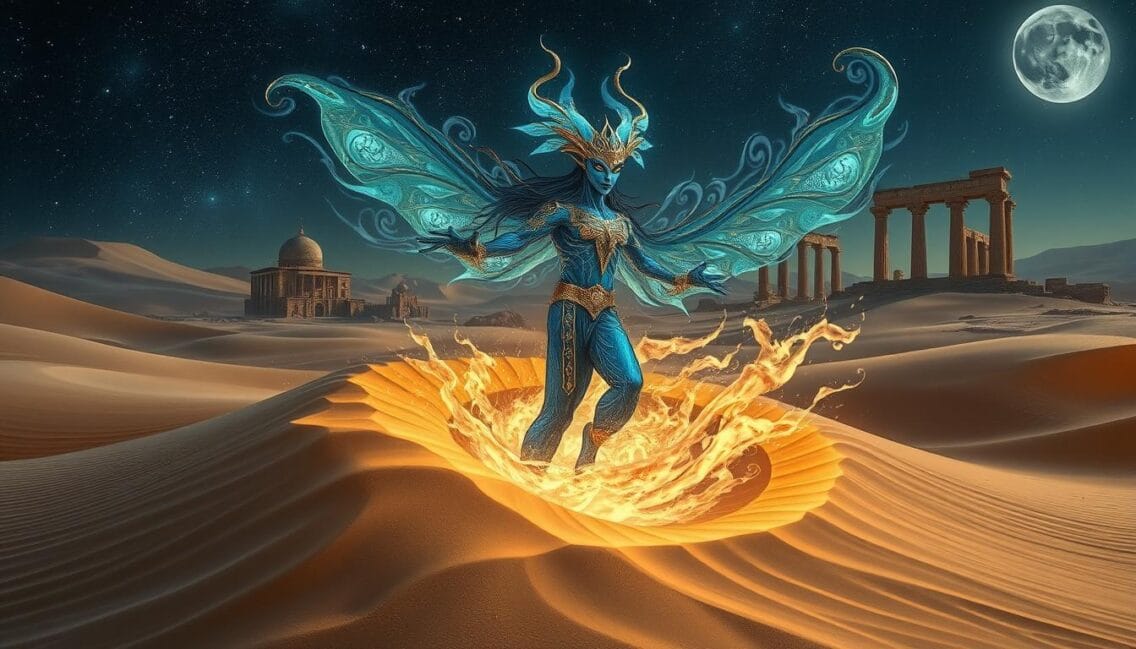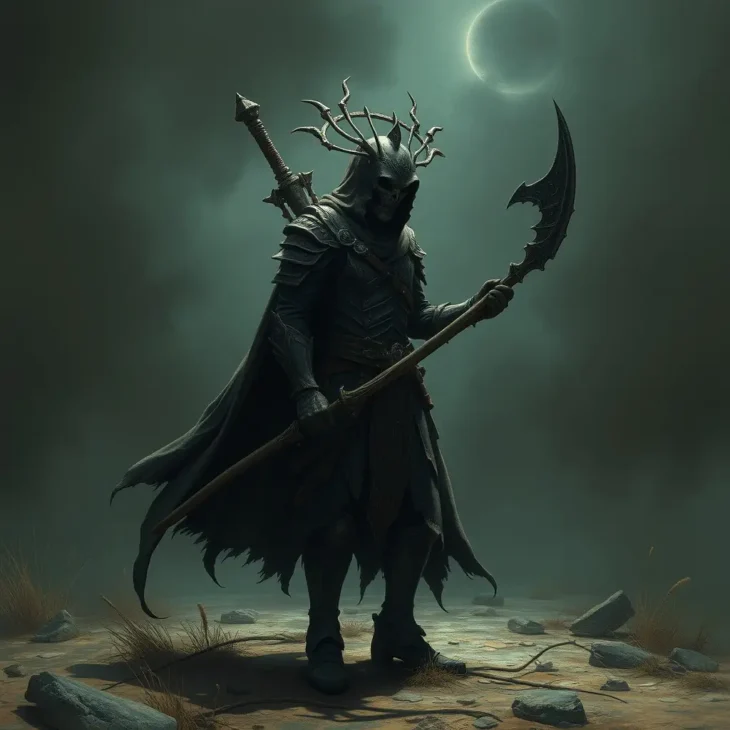Banishing Djinn: Middle Eastern Folklore on Protection

Ever felt a chill, like unseen eyes were watching you? The belief in djinn, or genies, is deep in Middle Eastern folklore. It shapes the spiritual and cultural practices of the area. These supernatural beings can bless or curse humans.
Exploring the world of djinn reveals a complex mix of beliefs and rituals. These are all about protecting oneself from their harm. The Middle East is full of traditions aimed at keeping djinn at bay.
Unveiling the Mystical World of Djinn
Origins and Beliefs Surrounding the Unseen Realm
Predating Islam, djinn were seen as beings with both human and fire aspects. They were created before humans, from pure fire. These entities can be male or female and can change their form.
In Moroccan folklore, djinn are tied to earth, air, fire, or water. They are often linked to flowers, colors, or the number ‘7’. Some djinn bring good fortune, while others cause chaos.
The Unseen Realm of the djinn is a key part of Middle Eastern Folklore. It shows how these supernatural entities live among humans. Learning about the djinn gives us a peek into the Islamic Cosmology and its mystical side.
| Djinn Classification | Characteristics |
|---|---|
| Earth Djinn | Associated with stability, fertility, and the natural world |
| Air Djinn | Linked to movement, change, and the power of the wind |
| Fire Djinn | Embodying passion, energy, and the transformative power of fire |
| Water Djinn | Connected to the fluidity, cleansing, and the cycles of life |
The Concept of Djinn in Islamic Tradition
In Islamic cosmology, the belief in djinn is deeply rooted. These supernatural entities in Islam are mentioned in the Quran and Hadith. Their existence is seen as essential to the faith. The djinn are described as complex beings, capable of both good and evil actions.
The Quran says the djinn were created from fire, as mentioned in Verse 55:15. Scholars have studied the djinn in Arabic and European languages. Yet, there’s less research on them compared to angels.
The belief in djinn doesn’t contradict Islam’s monotheistic worship. Instead, it shows a unique view of spiritual entities. This belief in the unseen realm challenges Western views of Islam. It highlights Islam’s imaginative and creative side.
| Key Insights on Djinn in Islamic Tradition |
|---|
|
The djinn in Islam are seen as a unique group, separate from angels and demons. This shows Islam’s special view of the spiritual realm. Understanding the djinn is key to grasping Islamic cosmology.
Banishing Djinn: Middle Eastern Folklore on Incense and Prayers for Protection
Rituals and Practices for Warding Off Malevolent Forces
In Middle Eastern culture, the djinn has a big impact. These beings live in a world next to ours and are talked about in many stories and spiritual acts. People try to keep them away or make friends with them.
Henna is used to keep bad spirits away. If a woman felt off, a special person might help her. They would do a Zar ritual, which includes dancing and music. This helps her deal with hard times in a society ruled by men.
Incense like agarwood, black seed, and Syrian Rue is also used. It’s part of Islamic Spirituality in the Middle East. People burn it to keep bad vibes and djinn away, making a safe and clean space.
Henna rituals and incense are part of the Middle Eastern stories about djinn. They have created many ways to keep djinn away. These practices are still important today.
The Evil Eye: A Potent Force in Middle Eastern Cultures
The Evil Eye, known as ain in Arabic, nazar in Turkish, and cheshm in Persian, is a big deal in the Middle East. It’s believed that a jealous stare can bring bad luck and harm. This happens if the gaze isn’t followed by a good wish.
Many people in the area think the Evil Eye causes their problems. So, they try hard to keep it away. They use old rituals and traditions that mix religion and culture.
- Using kohl, a black eyeliner, is a way to protect against evil spirits.
- Eye-shaped pendants and amulets are worn to keep away bad spiritual forces.
- Saying the opposite of what you mean is a trick to avoid envy and the Evil Eye.
These old beliefs and practices are still alive in the Middle East. They show how strong the Evil Eye is in people’s minds.
Symbols and Talismans for Protection
In the Middle East, many apotropaic symbols and talismans fight off the evil eye and bad spirits. The blue glass bead, called the nazar, is famous for keeping away bad gazes. The Hand of Fatima, named after the Prophet Muhammad’s daughter, has an eye in the center. It protects against bad luck.
Quranic recitations are very powerful in Islamic traditions. Verses like Surah al-Falaq and Surah an-Nas are often used for protection. People also burn incense, like agarwood and black seed, to keep away evil and clean negative energy.
| Apotropaic Symbol or Talisman | Description | Protective Qualities |
|---|---|---|
| Nazar (Blue Glass Bead) | A blue glass bead with an eye-like pattern in the center | Believed to deflect the evil eye and negative energy |
| Hand of Fatima | An open palm with an eye at the center, representing the Prophet Muhammad’s daughter | Protects against misfortune and wards off evil spirits |
| Quranic Recitations | Specific verses from the Quran, such as Surah al-Falaq and Surah an-Nas | Invoked to seek refuge from malevolent forces and evil jinns |
| Incense Burning | Burning of fragrant materials like agarwood, black seed, and Syrian Rue | Believed to ward off bad spirits and cleanse negative energy |
Exorcism Rituals and Spiritual Healers
In the Islamic world, many believe that spirits, like jinn, can take over a person. This is called al-‘azm or ruqya. Those who do exorcisms are called raqi. Symptoms of being possessed can be loud noises or even just feeling sick.
Islamic beliefs talk about different spirits that can take over a person. These include marrid (demons), bhut (evil spirits), and shayatin (devils). People seek out spiritual healers to get rid of these malevolent forces and find peace.
In the Middle East, exorcism rituals use the Quran, incense, and prayers. Spiritual healers, or raqi, are key in this fight. They use their knowledge and faith to help those being taken over by possessing jinn.
| Ritual Element | Purpose |
|---|---|
| Quranic Verses | Invokes the power of Allah to expel the jinn |
| Incense | Cleanses the environment and creates a sacred space |
| Prayers | Asks for divine intervention and protection |
These exorcism rituals and the help of spiritual healers are crucial in Islam. They help people face and defeat the unseen forces that can harm their lives and health.
Conclusion
The idea of djinn, or supernatural beings, has been key in Middle Eastern cultures for ages. These beliefs about djinn’s power to take over people are tied to Islamic tradition and Middle Eastern folklore. People use incense, Quranic verses, and seek out spiritual healers to fight off djinn.
This shows the deep spiritual and cultural roots of the Middle East. It’s a world where magic and the unseen realm are part of everyday life.
If you’re interested in supernatural beliefs or Islamic spirituality in the Middle East, this journey into djinn has given you a peek. It reveals the rich and diverse culture of the Middle East. The lasting impact of Middle Eastern folklore on people’s lives is truly remarkable.
FAQ
What are Djinn?
Djinn, also known as Jinn or Genies, are supernatural beings from the Quran and Islamic texts. They live in an unseen world. Along with humans and angels, they are God’s creations.
What are the origins and beliefs surrounding Djinn?
Djinn were seen as part human, part fire, like elementals in Western tales. In Moroccan folklore, they are elemental beings. They can be good or evil, bringing fortune or chaos.
How are Djinn represented in Islamic tradition?
In Islam, many believe Djinn can possess people. This is called al-‘azm or ruqya. Exorcists, or raqi, help to remove these entities.
The Quran and Hadith say demons can harm the heart. This turns souls away from good.
What rituals and practices are used to ward off Djinn and other malevolent forces?
To keep bad spirits away, people burn incense like agarwood or black seed. Quranic verses, especially Surah al-Falaq and Surah an-Nas, are also used.
What is the belief in the “evil eye” in Middle Eastern cultures?
The evil eye, or ain in Arabic, is feared in the Middle East. It’s believed to cause misfortune. People use rituals to protect themselves, blending religious and cultural practices.
What types of symbols and talismans are used for protection?
Many symbols and talismans fight the evil eye and evil forces. Blue glass beads, the Hand of Fatima, and Quranic verses are used for protection.
What are the practices and rituals involved in exorcism and spiritual healing?
In the Islamic world, many believe in Jinn possession. Exorcism and spiritual healing by raqi are common. They aim to remove evil forces and bring balance.



